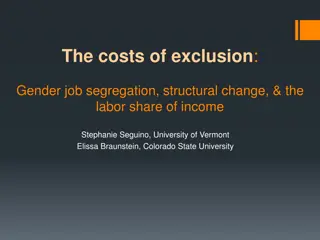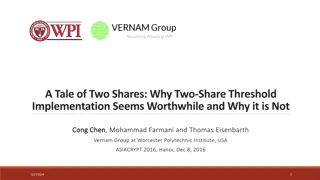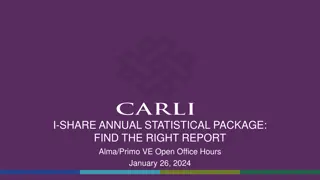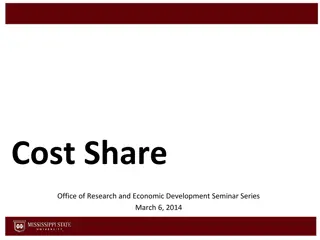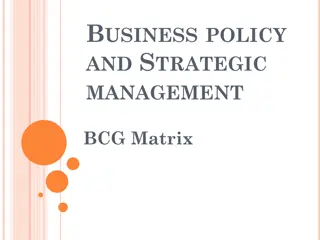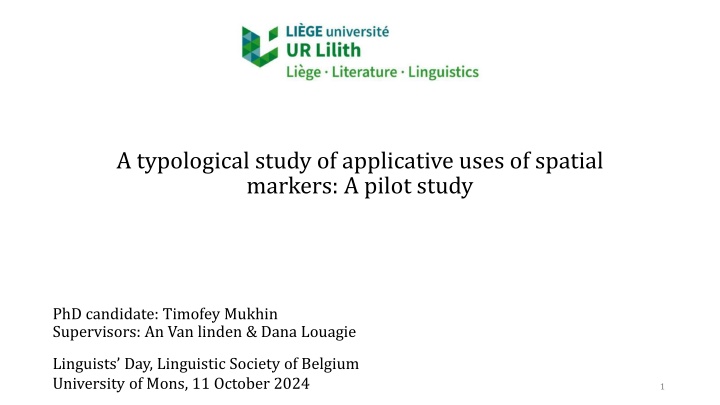
Spatial Markers in Linguistic Studies: A Pilot Exploration
Explore the applicative uses of spatial markers in linguistic research conducted by PhD candidate Timofey Mukhin. The study delves into the concept of applicatives, their sources, and spatial verb morphology. Research questions examine the prevalence and characteristics of spatial markers with applicative uses. Join this linguistic journey to discover patterns and variations in language structures.
Download Presentation

Please find below an Image/Link to download the presentation.
The content on the website is provided AS IS for your information and personal use only. It may not be sold, licensed, or shared on other websites without obtaining consent from the author. If you encounter any issues during the download, it is possible that the publisher has removed the file from their server.
You are allowed to download the files provided on this website for personal or commercial use, subject to the condition that they are used lawfully. All files are the property of their respective owners.
The content on the website is provided AS IS for your information and personal use only. It may not be sold, licensed, or shared on other websites without obtaining consent from the author.
E N D
Presentation Transcript
A typological study of applicative uses of spatial markers: A pilot study PhD candidate: Timofey Mukhin Supervisors: An Van linden & Dana Louagie Linguists Day, Linguistic Society of Belgium University of Mons, 11 October 2024 1
Outline 1. Introduction 2. Sample & data collection 3. Analysis & results 4. Conclusion 2
What are applicatives? (1) San Lucas Quiavin Zapotec (Zapotecan; Munro 2000: 285 286 cited in Z iga & Creissels 2024: 4) a. B- i lly Gye eihlly c hnn Jwaany. PFV-sing M. with J. b. B- i lly-n e Gye eihlly [Jwaany]. PFV-sing-APPL M. J. Mike sang with John. Base Construction = BC Applicative Construction = AC Applicatives: morphological verb markers that increase the valency of verbs (= the number of arguments), by allowing the coding of a thematically peripheral argument or adjunct as a core-object argument (Peterson 2007: 1). Broader definition from Z iga & Creissels (2024: 4): introduced argument (applied phrase) need not be a core argument APPL applicative; PFV perfective 4
Previously established sources Traditionally two independent (direct) sources for applicatives: adpositions and verbs (Peterson 2007:125) New sources: + nouns (as direct source) (Nordlinger 2019: 423; Arkadiev 2021: 50) + classifiers (Rose 2019) + spatial verb morphology (Van linden 2022; Payne 2021) 5
Spatial verb morphology Harakmbut (isolate, SA; Van linden 2022: 130, 142, 148) (2) ken-ta r -t DIST-LOC filler-LOCpatio-LOC Then, eh, they planted her on the patio for him [i.e. the jaguar] kuru-te on-ni -on-tuk-po 3PL.IND-BEN.APPL-SPAT:on-plant-DEP spatial marker (3) o-wedn-ato 3SG.IND-lie-AM:move&do FILLERbicycle He falls (literally: moves and lies down ), eh, he falls onto his bike. n [bisikleta] o-n-kot 3SG.IND-SPAT:on-fall spatial, applicative (4) men-pa which-manner 3PL.DUB-SPAT:on-do-REM.PST.INDIR.EVD aunt How did they do it to him, auntie? an-on-ka-tuy, tia non-spatial, applicative single grammaticalization path AM associated motion; APPL applicative; BEN beneficiary; DEP dependent verb form; DIST distal; DUB dubitative; FILLER filler; IND indicative; INDIR.EVD indirect evidential; LOC locative; PL plural; REM.PST remote past; SG singular; SPAT spatial prefix; 3 third person 6
Research questions RQ1: How widespread is the applicative use of spatial markers in the world s languages? Any areal/genetic patterns? RQ2: What are the characteristics of spatial markers with applicative uses or applicative markers of spatial origin? Some parameters of variation: (i) functional type of spatial markers (SMs) (ii) syntactic effect of the applicative marker (iii) semantic role of the applied phrase 7
Sample and data collection Figure 1. 75-language sample 75 languages (ultimate goal: 240) Genus-Macroarea method (Miestamo 2005): unrelated at level of genus from 6 macroareas in proportion to their genealogical diversity + from most recent sources All the maps are created using the lingtypology package for R (Moroz 2017). 9
RQ1 23% (n=17) languages of the sample 25 markers so far Figure 2. Spatial markers with applicative uses 11
Parameters of variation (RQ2) (i) functional type of spatial markers (SMs) (ii) syntactic effect of the applicative marker (iii) semantic role of the applied phrase General problem with (i): so far, no comprehensive typological studies of spatial verb morphology which provide an overview of all possible types of SMs (Plungian 2002: 3; Forker 2019: 92; Ross 2021: 32) Bottom-up approach: data from grammars language reports typology of the parameters of variation 12
RQ2: (i) type of spatial marker Classification in this study based on two parameters: 1. Type of spatial meaning coded (Guillaume & Koch 2021: 3; Ross 2021: 35; Ganenkov 2009: 127; Kibrik 1970) Direction (e.g. VENTIVE go come) Localization (e.g. SUPER sleep on X) Associated Motion (e.g. SUBSEQUENT VENTIVE sleep and then come) 2. Semantic type of verb with which SM is attested Motion verb (e.g. walk) Non-motion verb (e.g. sleep) Two major classes of SMs: Dedicated = one meaning regardless of the verb type Mixed = various types of meanings with different types of verb 13
RQ2: (i) type of spatial marker (5) Abaza (Northwest Caucasian, E) (Arkadiev 2021: 40), (O Herin 2002: 64) a. non-motion verb: localization SUPER (contactless) a- n a- DEF-youth DEF-spring 3SG.H.ABS-3SG.N.IO-LOC-sleep(AOR)-DECL The guy fell asleep over the spring of water. d-a-qa- - b. motion verb: direction upwards a-mara (j-) a-qa-l- j-d DEF-sun (3SG.N.ABS-)CISL-LOC-go.in-PRS-DECL The sun rises . qa- = DIR/LOC AOR aorist; ABS absolutive; CISL cislocative; DECL declarative; DEF definite; H human; IO indirect object; LOC locative; N non-human; PRS present; SG singular; 3 third person 14
Results RQ2: (i) type of spatial marker Table 1. Types of SMs attested with applicative uses AM DIR/AM 16% (4) DIR 28% (7) DIR/LOC 40% (10) total 25 attested types of SMs 16% (4) Direction(+Motion) Localization DIR/LOC SUPER (n=7) or IN (n=3) AM, DIR/AM, DIR no preferences 15
RQ2: (ii) syntactic effect of applicative 1. Syntactic Status of the applied phrase (AppP) in the AC: P-applicative AppP = direct object D-applicative AppP = dative/indirect object X-applicative AppP = oblique 2. Status of the semantic equivalent (BaseP) of the AppP in the BC: Optional applicative BaseP present in the BC Obligatory applicative BaseP obligatorily absent from the BC 3. Sensitivity to syntactic valency (relevant for P-applicatives): Transitivizing applicative increases number of core syntactic arguments in BC Redirecting applicative introduction of AppP + demotion of non-Actor argument (up to omission) 16
RQ2: (ii) syntactic effect of applicative Georgian (Kartvelian, E; Hewitt 1995: 184) (6) locative optional D-applicative a. k'ac-ma k'onvert -ze man-ERG envelope-on b. k'ac-ma [k'onvert -s] man-ERG envelope-DAT The man wrote the address on the envelope. misamart-I address-NOM misamart-I address-NOM da-( -)c'er-a PREV-(it-)write-he(AOR) da-( - -)a-c'er-a PREV-(it-it-)APPL-write-he(AOR) BC AC Murui (Witotoan, SA; Wojtylak 2020: 344) (7) source obligatory X-applicative [Alexis jo-fo-mona] Alexis house-CLF-ABL Francisca=at-CLF-LOC From the house of Alexis (she) came to eat at Francisca s. Fransiska=d -no-moloc gui-za bi-t-epred eat-VENTV-LK-3 Simplified: ABL ablative; AOR aorist; APPL applicative; CLF classifier; DAT dative; ERG ergative; LK linker; NOM nominative; PREV preverb; VENTV ventive; 3 third person 17
RQ2: (ii) syntactic effect of applicative Agar Dinka (Nilotic, not in the sample; Andersen 1992-1994: 10 cited in Payne 2021: 719) (8) P-applicative (redirecting) a. k -b k boy DECL-throw bird The boy is throwing at the bird. b. k -b ok boy DECL-throw:ITVstone The boy is throwing a stone thither. d t BC [do ot] AC Direct object = Goal in BC (8a) Direct object = Theme in AC (8b) DECL declarative; ITV itive 18
Results RQ2: (ii) syntactic effect of applicative Table 2. Syntactic effect of SM with applicative uses Obligatory P-applicative 60% (15) D-applicative 0 X-applicative 12% (3) total 72% (18) Optional 16% (4) 12% (3) 0 28% (7) Total 76% (19) 12% (3) 12% (3) 100% (25) Not attested in the pilot sample: Obligatory D-applicative Optional X-applicative: also not attested cross-linguistically (Z iga & Creissels 2024: 21) Redirecting applicative 19
RQ2: (iii) semantic role of AppP Table 3. Attested semantic roles of AppP role type Spatial semantic role Source Goal Location Recipient Beneficiary Maleficiary Instrument Comitative Experiencer Reason Stimulus Subject matter Standard of comparison example walk from X walk to X walk in X send to X fish for X cast a spell on X walk using X walk with X smth happened to X kill because of X dream of X lie about X be taller than X Functions of applicative markers: Adding a spatial applied phrase Adding a non-spatial applied phrase Non-spatial 20
RQ2: (iii) semantic role of AppP: spatial spatial, applicative non-spatial, applicative spatial marker Murui (Witotoan, SA; Wojtylak 2020: 532, 375, 434, 344) (9)ventive/reversive directional bi-e nokae da-ma this.CTS-CLF canoe one-CLF rii-za bi-d-epred arrive-VENTV-LK-3 This canoe floated away (lit. alone) at the lake, and, once again, it came back. fa ri-ya -kai-d-epredjoraida float-?-INCP-LK-3 ie CONN once again dane ab do lake (10=7) source obligatory X-applicative/prior subject ventive AM (motion-cum-purpose) [Alexis jo-fo-mona] Fransiska=d -no-moloc Alexis house-CLF-ABL Francisca=at-CLF-LOC From the house of Alexis (she) came to eat at Francisca s. Simplified: ABL ablative; CLF classifier; CONN connective; CTS close to speaker; INCP inceptive; LK linker; LOC locative; VENTV ventive; 3 third person gui-za bi-t-epred eat-VENTV-LK-3 21
RQ2: (iii) semantic role of AppP: refuting hypothesis spatial, applicative non-spatial, applicative spatial marker Tikuna (Tikuna, SA; Bertet 2020 : 218, 583) (11) SUPER(/DIST) locational ye -m n = DIST-ANAPH 3M=beand t =ch -p t - 3.SBJ=be.there.pl-across-SUB So, they would spend their time over there, at the edge of the jungle r y - k = a DIST.PLOC-approx=QUOT p m -gu = a edge.of.the.jungle-PLOC=QUOT (12) experiencer obligatory P-applicative [m r m - e PRF be.several-REL [...] this thing has happened to several people. y =d - e - ] LK=be.a.human-REL-ACC 3M=be.there.sg-across LK=PROX-EXO case n = -p t i= - caso Simplified: ACC accusative; ANAPH anaphoric; DIST distal; EXO exophoric; LK linker; M masculine; PLOC punctual locative; PROX proximal; PRF perfect; QUOT quotative; REL relativizer; SBJ subject; SUB subordinator; 3 third person 22
Results RQ2: (iii) semantic role of AppP Figure 3. Types of semantic role(s) of Applied phrase 23
Results RQ2: type of spatial marker & semantic role Skewed distribution of non-spatial semantic roles over types of SMs: Beneficiary, Standard of Comparison, Subject Matter: only attested with AM, DIR or DIR/AM markers (never with Localization markers) Maleficiary, Reason, Comitative, Experiencer: only attested with Localization markers (DIR/LOC) Recipient, Stimulus, Instrument: no bias Table 4. Semantic roles attested for different types of SMs BEN No Localization (n=10) 2 SOC 2 SUBJM 1 REC 2 STIM 2 INST 1 EXP COM REAS MAL Table 5. Non-spatial roles of AppP per SM type (SM might add 1 semantic role) Localization (n=15) 1 2 1 1 2 4 4 24
RQ1: How widespread is the applicative use of spatial markers in the worlds languages? Any areal/genetic patterns? Relevant markers: 23% languages of the sample (17 out of 75 languages), 25 markers attested so far Attested in all macroareas >50% (n=14) of the cases in South America 26
RQ2: What are the characteristics of spatial markers with applicative uses or applicative markers of spatial origin? (i) type of spatial marker Most frequent: DIR/LOC (40%: n=10) If Localization: either SUPER or IN (ii) syntactic effect of applicative X-applicatives typically obligatory (n=3); D-applicatives typically optional (n=3); P-applicatives more often obligatory (n=15) than optional (n=4) (iii) semantic role of AppP Skewed distribution of non-spatial semantic roles over types of SMs 27
Further research questions RQ3: What do our findings tell us about the correlations established in the literature? E.g., Peterson s hierarchy (2007: 229) of the semantic roles of applied phrases: BEN > INST, COM > LOC, CIRCUM RQ4: What are the diachronic implications of our findings? 28
References (1) Andersen, T. 1992 1994. Morphological stratification in Dinka: On the alternations of voice quality, vowel length and tone in the morphology of transitive verbal roots in a monosyllabic language. Studies in African Linguistics 23(1), 1 63. Arkadiev, P. 2021. Between noun incorporation and lexical affixation in Northwest Caucasian (with focus on Abaza). Paper presented at Stockholm University, 9 Dec 2021, online. Belkadi, A. 2016. Associated Motion Constructions in African Languages. Africana Linguistica 22, 43 70. Bertet, D. 2020. Aspects of Tikuna grammar (San Martin de Amacayacu variety, Colombia) : phonology, nominal phrase, predicative phrase. Broadwell, G. A. 2006. A Choctaw Reference Grammar. (Studies in the anthropology of North American Indians.) Lincoln: University of Nebraska Press. Dixon, R. M. W. 2004, The Jarawara Language of Southern Amazonia, Oxford University Press. Forker, D. 2019. Elevation as a category of grammar: Sanzhi Dargwa and beyond. Linguistic Typology 23(1). 59 106. https://doi.org/10.1515/lingty-2019-0001 Ganenkov, Dmitry. 2009. Towards a typology of attachment markers: Evidence from East Caucasian languages. In Patience Epps & Alexandre Arkhipov (eds.), New challenges in typology: Transcending the borders and refining the distinctions, 127 148. Berlin: Mouton de Gruyter. Guillaume, A. & Koch, H. (eds.). 2021. Associated Motion, Berlin: De Gruyter. Gu rois, R., Gibson, H. & Persohn, B. 2021. Associated motion in Bantu languages. In Guillaume, A. & Koch, H. (eds.), Associated motion, 569-610. Berlin: De Gruyter. 29
References (2) Kibrik, A.E. 1970 K tipologii prostranstvennykh znachenii (na materiale padezhnykh sistem dagestanskikh yazykov) [Towards a typology of locative meanings (based on case systems of Daghestanian languages)], Yazyk i chelovek, 110 156. Hewitt, B. G. 1995. Georgian: A Structural Reference Grammar. Amsterdam: John Benjamins. Miestamo, M. 2005. Standard negation, Berlin: Mouton de Gruyter. Miestamo, M., Bakker, D. & Arppe, A. 2016. Sampling for variety. Linguistic Typology, 20(2), 233 296. https://doi.org/10.1515/lingty-2016-0006 Moroz G. 2017. lingtypology: easy mapping for Linguistic Typology. https://CRAN.Rproject.org/package=lingtypology. Munro, P. 2000. The leaky grammar of the Chickasaw applicatives. In Okrent, A. & Boyle, J. (eds.), The proceedings from the main session of the Chicago Linguistic Society s thirty-sixth meeting, 285 310. Chicago: Chicago Linguistic Society. Nordlinger, Rachel. 2019. From body part to applicative: Encoding source in Murrinhpatha. Linguistic Typology 23(3). 401 433. O Herin, B. 2002. Case and Agreement in Abaza. Arlington: SIL International & University of Texas Press. Payne, D.L. 2021. The extension of associated motion to direction, aspect and argument structure in Nilotic languages. In Guillaume, A. & Koch, H. (eds.), Associated motion, 695-746. Berlin: De Gruyter. Peterson D.A. 2007. Applicative constructions. Oxford: Oxford University Press. 30
References (3) Plungian, V. A. 2002. O specifike vyra enija imennyx prostranstvennyx xarakteristik v glagole: Kategorija glagol noj orientacii [On the specifics of the expression of nominal spatial properties on the verb: The category of verbal orientation]. In Plungian, V. A. (ed.), Issledovanija po teorii grammatiki. Vyp. 2: Grammatikalizacija prostranstvennyx zna enij v jazykax mira, 57 98. Moscow: Russkie Slovari. Rose, Fran oise. 2019. From classifiers to applicatives in Moje o Trinitario: A new source for applicative markers. Linguistic Typology 23 (3). 435 466. Ross, D. 2021. A crosslinguistic survey of Associated Motion and Directionals. In Guillaume, A. & Koch, H. (eds.), Associated Motion, 31 86. Berlin: de Gruyter Mouton. Van linden, A. 2022. Spatial prefixes as applicatives in Harakmbut. In S. Pacchiarotti & F. Z iga (eds.), Applicative morphology: Neglected syntactic and non-syntactic, 129-159. Berlin: De Gruyter. Wojtylak, K. I. 2020. A Grammar of Murui (Bue): A Witotoan language of Northwest Amazonia. Leiden: Brill. Zuniga, F. & Denis C. 2024. Applicative Constructions in the World s Languages, Berlin, Boston: Mouton de Gruyter. 31
Thank you! Timofey Mukhin <tmukhin@uliege.be> An Van linden <an.vanlinden@uliege.be> Dana Louagie <dana.louagie@uliege.be> 32





